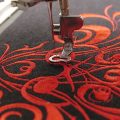In every aspect of life, the digital world is rapidly evolving. Nowadays, all forms of craftsmanship are becoming computerized. And embroidery digitalization is taking centre stage in the world of art. The varieties of embroidery digitization are chosen based on the requirements, design, and material.
Nevertheless, embroidery digitizing is more complicated than simply downloading your image file to the embroidery machine and starting it up. It’s far more complicated than that. Converting digital photographs into embroidered designs is not entirely automated since machines cannot detect and interpret the duplicate files that your computer can. So, we must first turn them into a digitized design because that is the language that an embroidery machine understands.
BitsnPixs provides unique embroidery digitizing services for various applications, including recreational, personal, or commercial use.
Digitizing Embroidery Patterns:
The photos and designs are into stitches that a machine can understand in the digitization program. So, embroidery digitization is like painting in that it is a tracing done using stitches. Understanding the various embroidery digitizing is a critical element of the solution.
When examining and selecting the various types of embroidery digitizing, there are numerous aspects and options to consider. Let’s look at the different types and how they may help you choose the ideal one for your company.
Digitizing Flat Embroidery:
Flat embroidery digitization is a popular method of digitized embroidery. It entails directly applying pattern stitching to the fabric backing to create an ornate flat design.
Because this procedure does not alter the images or designs, it is widely used for ornamentation. Flat embroidery is most employed when the patterns to be stitched are complex and involved.
Digitizing Tactile Embroidery:
Designs are created in patchwork embroidery digitizing by sewing or gluing woven pieces or designed fabric patches onto more significant parts to generate a specific pattern. They are attaching many more minor designs, resulting in larger patterns.
Embroidery with Soft Fabric:
You’ve seen some embroidery patterns using soft and fuzzy fabric. All of this is due to the soft cotton embroidery digitizing. Chenille is created by twisting together short threads, which gives it its distinctive softness and texture. When designing with soft cotton digitizing, special consideration is given to yarn density.
Embroidery with Beading:
Beaded embroidery machines must be outfitted with a sequin dispenser. As the gadget stitch, the dispenser sprinkles sequins onto the fabric. In most cases, sequin embroidery incorporates plastic discs, material, a rough surface, and a high shine.
This approach is worthwhile because it makes achieving excellent results and more fantastic layouts easier.
Embroidery using Folding:
Twine embroidery digitizing entails creating unique convex motifs to get a 3D look. This embroidery digitization technique is best suited for children’s items and home decor materials.
Embroidery Using Link Stitching:
Link stitching embroidery digitizing is ideal for designs that incorporate loops and stitches to create chain-like patterns. Compared to other embroidery digitizing methods, this technique is typically slow and challenging, and the designs may not be very appealing. It also makes extensive use of fabric.
Digitizing Photographs:
As a result of the photo embroidery digitization technique, the design on the material appears to be an artist’s work on canvas. It has multi-layered and multi-coloured embroidery that adds volume and color tone variation to the artwork.
Digitization of Borer Embroidery:
BitsnPixs’ machines are equipped with superb instruments to sew perfect stitches in the fabric. Embroidery digitizing includes designs with borer holes caused by needle penetrations, independent of stitch type.
Digitizing Fabric Embroidery:
BitsnPixs specializes in embroidery digitizing. Our professional experts and the machinery ensure that the lace patterns are gap-free and freestanding, avoiding the frequent gaps between the inner netting designs and the satin stitch borders of the digitized embroidery design.
Conclusion:
It is hard to determine the type of embroidery digitizing. Everything is dependent on the design, specifications, materials, and a few other factors, and it necessitates excessive neatness, undivided attention, and flawless expertise. That is what you will find at BitsnPixs. Our crew is always available for consultation and is only a few clicks away from assisting you in selecting the sort of embroidery digitizing best suited for you.
Also Read: What is Digitizing for Machine Embroidery? And Why Do I Need It?







































No Comments